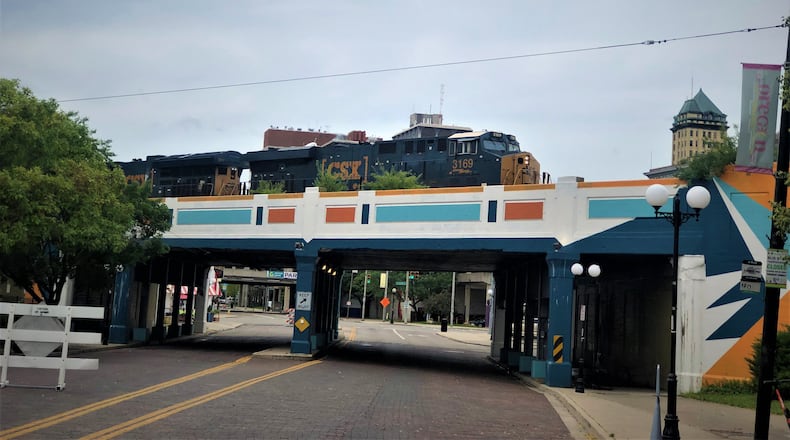That funding is related to the passage of a bipartisan federal infrastructure bill signed Monday by President Joe Biden. Wilt said that local leaders still need to look at what potential funding would look like as well as other details related to the local financial impacts of a rail project of that kind.
“There are considerations in terms of what the cost is and investment for something like that and what the return will be on that investment,” she added.
Although the federal legislation will provide billions of dollars for rail projects, much of the funding is competitive, and state and regional officials say they do not know how Ohio’s proposal will stack up against projects in other places, or whether state lawmakers and leaders will provide crucial support.
Dayton Mayor Nan Whaley, who is running for governor, said the state has rejected federal funding in the past for potentially transformative investments, including $400 million it was awarded more than a decade ago for passenger rail.
“There’s a lot of devils in the details here, because they were very clear at Amtrak when they were talking about the 3C+D line (connecting Cleveland, Columbus, Cincinnati and Dayton) that the state has to do a match with them as well,” Whaley said.
Dan Tierney, a spokesman for Ohio Gov. Mike DeWine, said, “We are reviewing the infrastructure bill to determine potential effects and opportunities here in Ohio, so it is a bit premature to comment on any passenger rail proposals.”
Biden signed the $1.2 trillion infrastructure bill, which includes $66 billion in additional funding for rail maintenance, upgrades and expansion — the largest investment in passenger rail since Amtrak was created 50 years ago, according to the White House.
The legislation provides $36 billion in grants for state-federal partnerships for intercity passenger rail projects, though up to $24 billion could go to projects in the northeast corridor.
Amtrak officials and some Ohio mayors and other leaders support new passenger rail service linking Cleveland, Columbus, Cincinnati and Dayton. The new route would be called the 3C+D corridor.
It would also include a stop in Springfield in Clark County, according to proposal maps.
“This would be a game changer for communities like Springfield,” said Mike McDorman, the president and CEO of the Greater Springfield Partnership, regarding renewed discussions related to the potential rail project.
“We are prepared for discussions on how we can bring this opportunity to Springfield,” he added, noting that the partnership was involved in similar talks more than a decade ago.
During a recent interview with “Axios on HBO,” Amtrak CEO Bill Flynn called the $66 billion set-aside for rail “absolutely transformational” and “more funding than we’ve had in our 50 years of history combined.”
About half of the funding would go toward building out intercity passenger rail across the country, he said, including in areas where such service is currently very limited or doesn’t exist.
“Phoenix to Tucson is a great example,” Flynn said. “Or Cleveland, Columbus, Dayton, Cincinnati.”
Amtrak supports resuming passenger rail service in Dayton, which was eliminated in 1979, Amtrak spokesperson Marc Magliari told this news organization.
Magliari said the infrastructure bill creates a competitive grant program that will be run by the Federal Railroad Administration.
He said Amtrak will work with the administration and state partners to identify and advance new corridor routes.
But little is known about the administration’s grant program at this time.
“It’s pretty early in the process,” Magliari said. “I can’t speak to a program that’s not been developed yet.”
Passenger rail is the missing ingredient in the comprehensive transportation network, said Brian Martin, executive director of the Miami Valley Regional Planning Commission.
The commission will continue to advocate for critical rail service connectivity, and the infrastructure bill brings this proposed route one step closer to reality, Martin said.
But passenger rail funding is competitive and likely will require matching funds, and states that make financial commitments to rail projects and agree to partner with Amtrak are more likely to receive awards, said Mayor Whaley.
Whaley said local leaders will continue to push for the 3C+D corridor, but many state lawmakers and Gov. DeWine have not signaled whether they will support the project.
“I think it could happen,” she said. “If I was elected governor, it would be like a priority for us.”
After John Kasich was elected Ohio’s governor in 2010, he declined to accept $400 million in federal funds that the state was awarded for a passenger rail to connect Dayton, Cleveland, Columbus and Cincinnati.
Kasich described the train project as a “money pit” that would need millions of dollars in state subsidies each year, and he said the train traveled too slow to be a high-demand form of transportation.
This new federal funding increases the chances that the 3C+D corridor will materialize, but there needs to be additional vetting of long-term costs and passenger projections, said Thea Ewing, director of transportation and infrastructure development with the Mid-Ohio Regional Planning Commission.
Ewing said the commission doesn’t yet know the full requirements of the federal funding programs passed in the infrastructure bill, but this is a big opportunity for the state.
“Passenger rail service along the 3C+D Corridor in Ohio would create additional transportation opportunities to people accessing jobs, education, healthcare and recreational opportunities beyond their home region,” she said.
Staff writer Jen Balduf contributed to this story.




